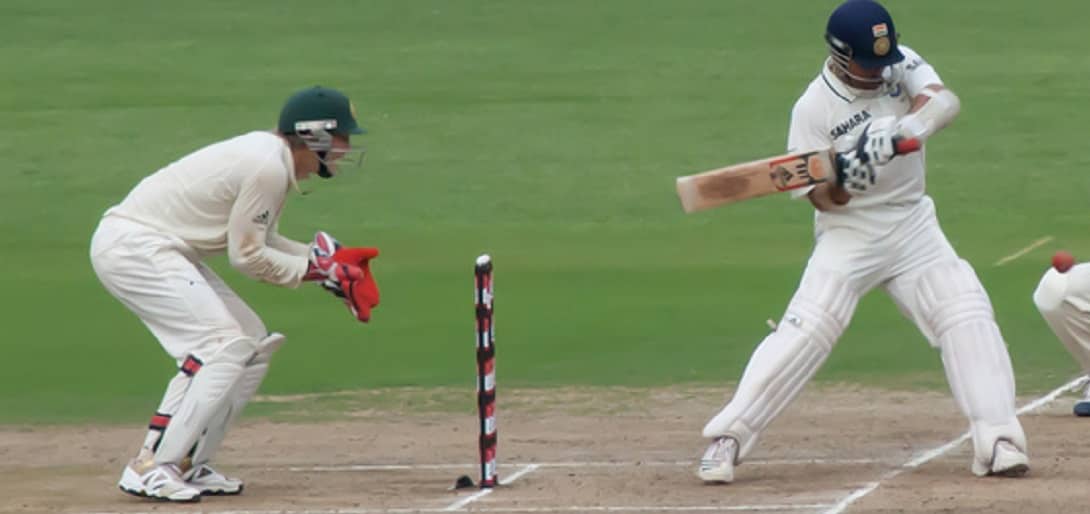Sachin Tendulkar and the rest of the Indian team was involved in a huge cricketing controversy on their 2001 tour of South Africa. What exactly happened there, who was at fault and what were the ramifications of the issue have all been discussed and outlined in this post below.
The 2001 India’s tour of South Africa
This was India’s third ever tour of South Africa, having played in the country in 1992 and 1996. The two sides were going to be involved in only a three-match Test series.
Those were days when India wasn’t the greatest touring team and in both those previous tours to the Rainbow nation, they had lost the series – going down 1-0 and 2-0 respectively.
Which is when they capitulated after making a strong start in the first Test at Goodyear Park in Bloemfontein, losing it by nine wickets, it was a disappointing result but not a very surprising one.
Virender Sehwag slammed his maiden Test century and Tendulkar had scored a blazing 155 but it wasn’t enough to stop the strong home team from marching to a 1-0 lead.
What happened in the Port Elizabeth Test match?
St. Georges Park in Port Elizabeth was the venue for the second Test match. India had come into the game knowing they were up against it but under the leadership of Sourav Ganguly decided to fight fire with fire.
While Herschelle Gibbs blazed away to a sizzling innings of 196, Javagal Srinath’s six-wicket haul helped India restrict South Africa to 362 in their first innings.
In reply, India capitulated to 201 with only VVS Laxman’s 89 helping India overcome a score of 69 for five at one stage to post 201. South African captain Shaun Pollock grabbed a five-fer.
Armed with a lead of 161 runs, South Africa eased their way to 233/5 before declaring their second innings and setting India a target of 395. More realistically, India needed to survive 108 overs in order to remain alive going into the third and the final Test.
While they lost Shiv Sunder Das for a duck, a second wicket partnership between Deep Das Gupta and Rahul Dravid that lasted around 83 overs all but ensured India’s safety. The rest of the side held out for a fighting draw.
This was just the cricketing bit. Off the field, a storm was brewing because of all that happened on the field of play and the extreme reaction to it.
The brewing storm at Port Elizabeth
While all this was transpiring in the Test match, what was also happening was a slew of incidents which had caught the eye of the on-field umpires Ian Howell and Russell Tiffin and the match referee, Mike Denness.
One of the issues on hand was the alleged ruckus created by the Indian fielders because of their over-appealing. Harbhajan Singh was at the centre of this and saw many of the other fielders involved as well.
What looked to have irked the on-field umpires was the lack of action taken by the Indian captain Sourav Ganguly to hold his players back.
There was one appeal for a catch by Virender Sehwag despite having dropped the ball leading to further question-marks over the team’s on-field conduct.
The biggest issue came during a spell of bowling from Sachin Tendulkar.
Tendulkar, who had aspired to become a fast bowler as a kid before Aussie great Dennis Lillee advised him against it, had been invited to bowl a few overs of gentle medium-pace bowling on the third day of the Test.
While Tendulkar did not get any wickets, the four overs he bowled saw him get enough amount of swing movement to catch the eye of the host broadcaster. Zooming in to his bowling action, what was spotted by the camera was Tendulkar had moved his thumb and fingers on the seam of the ball on a couple of occasions.
In all probability it was an innocent act of cleaning the seam but under the laws of the sport, the umpires need to be informed beforehand.
Mike Denness goes on an overdrive
Based on what the umpires reported and match referee Mike Denness’ assessment of the situation, he went on to penalise six Indian players for a variety of reasons.
Tendulkar was accused of cleaning the ball without informing the umpires, and was given a suspended ban for one Test. Many in India considered was tantamount to saying he had cheated by tampering with the ball.
Sehwag was banned for a game for his excessive appealing antics in what was the biggest punishment of them while the remaining four players, Sourav Ganguly, Harbhajan Singh, Shiv Sunder Das and Deep Dasgupta got a suspended ban of one Test match for their excessive appealing too.
A suspended ban implied all of them – except Sehwag – were free to play the next game but another such misdemeanour in the following 12 months would lead to an immediate ban.
Media response to the Denness incident
Denness could have argued he went by the book but in hauling up so many players for over-appealing and one for ball tampering, he had angered many an Indian fan.
To top that, Denness was forced to front up to the angry Indian media by the South African cricket board after these penalties were announced but under his contract with the ICC he was prohibited from explaining his decisions in the press.
With Denness’ decision to keep mum in the press conference irking the media even more, Indian commentator Ravi Shastri, who was a part of that contingent that said, quipped, “If Mike Denness cannot answer questions, why is he here? We know what he looks like.”
Things came to such a head that the Indian team refused to accept the punishment and threatened to play Sehwag in the final Test despite his ban. The outrage in India was humongous with the word on the street being that the ICC and the match referee had been discriminatory in their dealings.
This had stemmed from the fact that South African captain Shaun Pollock himself had been caught appealing excessively but no charges had been brought against him.
What made the situation worse was that the ICC had been slow in diffusing the situation by having failed to explain the Tendulkar issue. He hadn’t been accused of ball-tampering but of having failed to inform the umpires that he had been cleaning the ball – which was an offence under the law.
In a report on ESPNCricinfo , cricketer writer Peter Robinson surmised, “It might even be fair to say that Denness has done far more damage to the game than the six players he punished.”
, cricketer writer Peter Robinson surmised, “It might even be fair to say that Denness has done far more damage to the game than the six players he punished.”
What happened next?
The Indian cricket board wanted to call off the tour of South Africa with a Test match to go unless the ICC changed the match referee for the third game. The ICC refused but the South African cricket board supported the BCCI and the third Test went on without Denness in the match referee’s box.
In fact, Denness wasn’t even allowed to enter the stadium and the United Cricket Board of South Africa (now CSA) replaced him with Dennis Lindsay.
And while Sehwag did not feature in the Test, the game was declared an unofficial Test match by the ICC as a result of Denness’ sacking. In a press release, the ICC explained:
The fundamental issue at stake is the right of the ICC, as the world governing body for cricket, to appoint referees and umpires, and for those officials to make decisions which are respected by both players and Boards. Without this right, the sport could descend into anarchy.
They added:
India and South Africa chose to reject the properly appointed ICC referee in this instance and on this basis, the match cannot be deemed a Test Match.
Later, the ICC would make it clear that any Test match with Sehwag playing in it would be deemed unofficial but back-tracked on their punishment of Tendulkar and Ganguly. Both were cleared of their penalties.
The BCCI picked Sehwag for their next England tour and refused to acknowledge that he would be dropped for one game, raising questions if any of the Tests against England would be official.
The ECB and ICC were forced to negotiate with BCCI on this and truce was achieved when the Indian cricket board agreed to not play Sehwag in the opening Test against England.
BCCI v Denness
A hearing for the case between BCCI and Denness was to be held in June 2002 in front of the ICC Disputes Resolution Committee which had Michael Beloff QC at its helm.
However, Denness had to undergo a heart surgery and the BCCI dropped its case on what was deemed to be “humanitarian grounds”.
Denness would go on to officiate in just five more internationals after this controversy, and while he would say that this was nothing to do with the Port Elizabeth controversy, it’s hard to make up one’s mind on that.
Photo Credit: Pulkit Sinha from Mumbai, India

